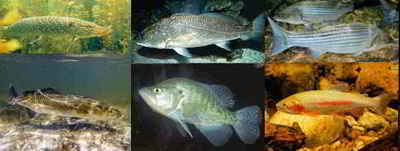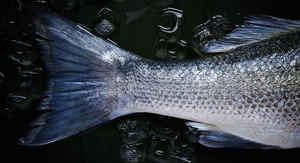Minnesota State Fish
Walleye Pike
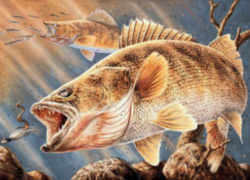
(Sander vitreus, formerly Stizostedion vitreum)
Adopted on May 25, 1965 .
The Walleye, (Sander vitreus) was designated Minnesota state fish in 1965, after having been proposed once before in 1953. (Minnesota Statutes
1.146)
The 1965 law was sponsored by Rep. Keith Hinman and Sen. Clifford Lofvegren. It was signed into law by Governor Karl Rolvaag.
Walleye, (Sander vitreus,) inhabit waters in all parts of the state, but mainly the large, cool lakes in northern Minnesota. Their eyes are sensitive to light, so they go to deep dark waters during the day and move to shallow lake areas at night. Minnesota's record walleye weighed 17 pounds 8 ounces.
Minnesota State Fish: Walleye Pike
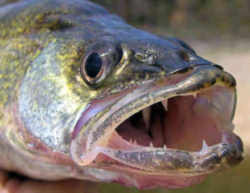
Walleye (Sander vitreus, formerly Stizostedion vitreum) is a freshwater perciform fish native to most of Canada and to the Northern United States. It is a North American close relative of the European pikeperch. The walleye is sometimes called the yellow walleye to distinguish it from the blue walleye, which is a subspecies that can be found in the southern Ontario and Quebec regions.
The walleye is the largest member of the perch family. It can grow to lengths of over 2 feet. The walleye's body shape is elongate, streamlined, and slightly compressed. The color of this fish is variable. It is generally brownish yellow to grayish yellow on the back and sides, shading to white on the belly. Young walleyes show vague saddle-shaped bands on the body. Walleyes differ from yellow perch in that they possess large canine-like jaw teeth.
Common Names:
Walleyed Pike, Pickerel, Jackfish, Dor
Walleye: given because of the smoky, silvery eye, which is said to be similar to that of blinded or "walleyed" domestic animals
Stizostedion means "pungent throat", according to the namer
vitreum means "glassy", alluding to the nature of the large, silvery eyes
Characteristics of the Walleye Pike
Walleye have a milky cast to their eyes. They have a long, round, olive body that has gold flecks on the sides with a white tip to the lower fork of the tail. There is a distinct black blotch on the rear end of the first dorsal fin.
Typical Adult:
Length: Up to 30 inches
Weight: Up to 10 pounds
Life span: Up to 26 years
Habitat:
Walleye are most numerous in large, cool, windswept lakes with low to moderate clarity. They also live in large rivers. The preferred water temperature is 65-75 °F.
Feeding Behavior:
Walleye most prefer other fish, but also eat aquatic insects, leeches, crayfish, snails, and larval salamanders. They normally feed in dim light.
Reproductive Behavior (Spawning):
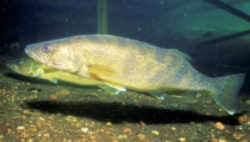
When: Walleye spawn in April and early-May
Preferred Water Temperature: Water temperatures in the shallows reach 4-7°C (40-45°F)
How: Walleye migrate from large lakes and rivers into small streams where they look for shallow gravel beds or areas of flooded vegetation. In lakes without good inlet streams, they move into shallow, rocky areas near shore. Walleye normally spawn during the night hours in about 0.3-1.5 m (1-5 ft) of water. Walleye are broadcast spawners, which means they swim above the spawning substrate (bottom material) and release their eggs and sperm into the water. Females release 200-300 eggs at a time, while one or more males fertilize them. This spawning act is repeated at roughly 5-minute intervals. A female may release all her eggs in a single night or may spawn over a period of several nights. Most males spawn for several nights. The fertilized eggs fall to the bottom, where they stick to the gravel or other bottom material. The parents give no care to the developing eggs (embryos actually) or the larvae that hatch from them. The embryos hatch in about 1-3 weeks, depending on the water temperature. In lakes, the larval walleye soon move into the deep, open water, where they develop into juveniles at about 25-30 mm. At this size they often return to the near shore areas of the lake, a movement pattern similar to the yellow perch
Minnesota Laws
The law designating the walleye as the official Minnesota state fish is Section 1.146 (State fish) of the Minnesota Statutes, Jurisdiction, Civil Divisions, Chapter 1, Section 1.146.
JURISDICTION, CIVIL DIVISIONS. CHAPTER 1 - SOVEREIGNTY, JURISDICTION, EMERGENCY OPERATION, GENERAL POLICIES. SECTION 1.146.
1.146 State fish.
Subdivision 1. Walleye. The walleye, Stizostedion v. vitreum, is the official fish of the state of Minnesota.
Subdivision 2. Photograph. A photograph of the walleye shall be preserved in the office of the secretary of state.
HIST: 1965 c 576 s 1,2; 1984 c 628 art 1 s 1
Copyright 2002 by the Office of Revisor of Statutes, State of Minnesota.
Taxonomic Hierarchy: Walleye
Kingdom: Animalia-- animals
Phylum: Chordata - chordates
Subphylum: Vertebrata - vertebrates
Class: Osteichthyes
Order: Perciformes
Family: Percidae
Genus: Stizostedion
Species: Stizostedion vitreum vitreum
